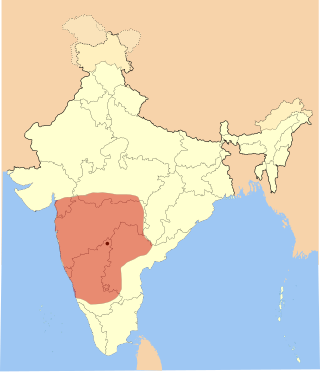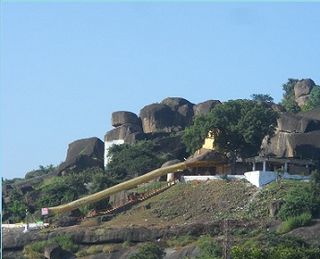
The Kakatiya dynasty was an Indian dynasty that ruled most of eastern Deccan region comprising present day Telangana and Andhra Pradesh, and parts of eastern Karnataka and southern Odisha between 12th and 14th centuries. Their capital was Orugallu, now known as Warangal.

The Telugu Cholas or Telugu Chodas ruled parts of present-day Andhra Pradesh between the sixth and the thirteenth century.

Tailapa II, also known as Taila II and by his title Ahavamalla, was the founder of the Western Chalukya dynasty in southern India. Tailapa claimed descent from the earlier Chalukyas of Vatapi, and initially ruled as a Rashtrakuta vassal from the Tardavadi-1000 province in the modern Bijapur district of Karnataka. When the Rashtrakuta power declined following an invasion by the Paramara king Siyaka, Tailapa overthrew the Rashtrakuta king Karka II, and established a new dynasty.

The Western Chalukya Empire ruled most of the western Deccan, South India, between the 10th and 12th centuries. This Kannadiga dynasty is sometimes called the Kalyani Chalukya after its regal capital at Kalyani, today's Basavakalyan in the modern Bidar District of Karnataka state, and alternatively the Later Chalukya from its theoretical relationship to the 6th-century Chalukya dynasty of Badami. The dynasty is called Western Chalukyas to differentiate from the contemporaneous Eastern Chalukyas of Vengi, a separate dynasty. Prior to the rise of these Chalukyas, the Rashtrakuta empire of Manyakheta controlled most of Deccan and Central India for over two centuries. In 973, seeing confusion in the Rashtrakuta empire after a successful invasion of their capital by the ruler of the Paramara dynasty of Malwa, Tailapa II, a feudatory of the Rashtrakuta Dynasty ruling from Bijapur region defeated his overlords and made Manyakheta his capital. The dynasty quickly rose to power and grew into an empire under Someshvara I who moved the capital to Kalyani.
Tailapa III succeeded Jagadhekamalla II to the Western Chalukya throne. His rule saw the beginning of the end of the Chalukya empire. Kakatiya dynasty's Prola II warred with him, defeated and took the Chalukya king captive. This resulted in other feudatories rising against the Chalukyas. The Seuna and the Hoysala started to take away territory. Kalachuri Bijjala II captured the regal capital Kalyani in 1157 when Tailapa III had to flee to Annigeri. Finally Tailapa III was killed by Hoysala Vira Narasimha in 1162.
Velanati Cholas were one of the Chola families who ruled over parts of the Andhra Pradesh in the 12th century. They were Vassals of Later Cholas and Western Chalukyas and ruled over the region of Kammanadu in modern Guntur district.
Gonka II was a Telugu king and the third of Velanati Chodas who ruled from 1132 to 1161.

Jagadeva, also known as Jagaddeva or Jagdev Parmar, was an 11th-12th century prince from the Paramara dynasty of central India. He is known from an inscription discovered at Jainad and some folk legends. His political status is uncertain, although according to one theory, he may have been a vassal of the Western Chalukyas.

Padmakshi Temple is one of the oldest temples in the Hanamakonda area of Telangana, India. It is dedicated to the Hindu goddess Padmakshi (Lakshmi), and also features Jain imagery.

The 11th century Paramara king Bhoja ruled from his capital at Dhara. The period of his reign is dated approximately 1010 CE to 1055 CE, although some historians believe that he ascended the throne before 1010 CE. Bhoja inherited a kingdom centered around the Malwa region, and made several attempts to expand it varying results. He managed to annex territories as far as northern parts of Konkan, but these territorial gains were short-lived. He fought wars against several of his neighbours, including the Chaulukyas of Gujarat, the Chalukyas of Lata, the Chalukyas of Kalyani, the Chandelas of Jejakabhukti, the Kachchhapaghatas of Gwalior, the Chahamanas of Shakambhari, the Chahamanas of Naddula, and the Kalachuris of Tripuri. He also conflicted with Gaznavid Turk Invaders, Mahmud's desecration of the Somnath temple in Gujarat motivated Bhoja to lead an army against him, however after Somnath raid, Mahmud Gazhnavi chose a more dangerous route via Sindh, to avoid facing the invading powerful armies of Bhoja.
Jaitugi, also known as Jaitrapala, was a ruler of the Seuna (Yadava) dynasty of Deccan region in India.
Bhillama II was a ruler of the Seuna (Yadava) dynasty of Deccan region in India. He was a vassal of the Kalyani Chalukya ruler Tailapa II, and played an important role in Tailapa's victory against the Paramara king Munja.
Prola II was a Kakatiya chief who ruled the area around Anumakomda as a vassal of the Kalyani Chalukyas. He was the father of Rudra-deva, the first sovereign ruler of the Kakatiya family.
Gunda IV alias Pindi-Gunda was a member of the Kakatiya dynasty of southern India. As a Rashtrakuta general, he helped the Vengi Chalukya prince Danarnava ascend the throne after a succession dispute. In 973 CE, after the collapse of the Rashtrakuta empire and the murder of Danarnava, he attempted to carve out an independent principality at Kuravi. The Kalyani Chalukyas, who had usurped the power from the Rashtrakutas, probably defeated and killed him, supported by the Mudugonda Chalukyas, the former rulers of Kuravi.
Beta I, also known as Garudanka Beta or Garuda Beta, was a member of the Kakatiya dynasty of southern India. His father Gunda IV was a Rashtrakuta vassal, and was killed in a conflict with the Kalyani Chalukyas who usurped the power from the Rashtrakutas. Beta accepted the suzerainty of the Kalyani Chalukyas, participated in their war against the Cholas, and obtained Anamkonda as fief.
Prola I was a member of the Kakatiya dynasty of southern India. As a Kalyani Chalukya vassal, he participated in prince Vikramaditya VI's campaigns, and consolidated the Kakatiya control over the area around Anumakonda by subjugating local chiefs. He obtained the Anumakonda vishaya and its neighbouring lands as a hereditary fief from the Chalukya king.
Beta II alias Tribhuvana-malla was a member of the Kakatiya dynasty of southern India. As a Kalyani Chalukya vassal, he obtained control of the Sabbi-1000 province centred around Vemulavada. He commissioned a Shaivite shrine, and also donated land for a Jaina temple.
Durga-raja was a member of the Kakatiya dynasty of southern India. He is attested by only one record - the 1098 CE Kazipet dargah inscription, which was issued during the reign of his father Beta II. According to one theory, he probably ruled for a short period and rebelled against his Kalyani Chalukya overlord, before being subjugated by his brother Prola II who remained loyal to the Chalukyas.
Mahadeva was a ruler of the Kakatiya dynasty which ruled in the present-day Telangana and Andhra Pradesh regions of India. He died in battle during an invasion of the neighbouring Seuna (Yadava) kingdom. The Yadavas captured his son Ganapati, but later reinstated him on the Kakatiya throne.
Ganapati-deva was the longest reigning monarch of the Kakatiya dynasty of southern India. He brought most of the Telugu-speaking region in present-day Andhra Pradesh and Telangana under the Kakatiya influence by war or diplomacy.







